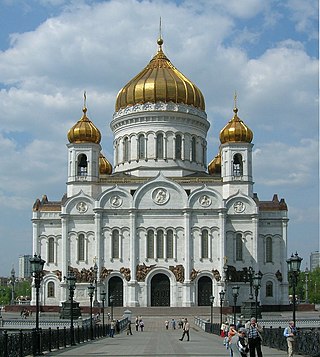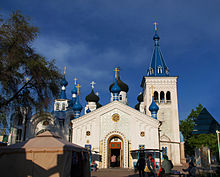
Bishkek, formerly Pishpek and Frunze, is the capital and largest city of Kyrgyzstan. Bishkek is also the administrative centre of the Chüy Region. The region surrounds the city, although the city itself is not part of the region but rather a region-level unit of Kyrgyzstan. Bishkek is situated near the border with Kazakhstan and has a population of 1,074,075, as of 2021.

Kyrgyzstan, officially the Kyrgyz Republic, is a landlocked country in Central Asia, lying in the Tian Shan and Pamir mountain ranges. Bishkek is the capital and largest city of the country. Kyrgyzstan is bordered by Kazakhstan to the north, Uzbekistan to the west, Tajikistan to the south, and China to the east and southeast. Ethnic Kyrgyz make up the majority of the country's 7 million people, followed by significant minorities of Uzbeks and Russians.

The Polish Autocephalous Orthodox Church, commonly known as the Polish Orthodox Church, or Orthodox Church of Poland, is one of the autocephalous Eastern Orthodox churches in full communion. The church was established in 1924, to accommodate Orthodox Christians of Polish descent in the eastern part of the country, when Poland regained its independence after the First World War.
The Catholic Church in Kyrgyzstan is part of the worldwide Catholic Church, under the spiritual leadership of the Pope in Rome.
Eastern Orthodoxy in Hungary refers to communities, institutions and organizations of the Eastern Orthodox Christianity in Hungary. Historically, Eastern Orthodoxy was an important denomination in the medieval and early modern Kingdom of Hungary. In modern times, Eastern Orthodoxy is mainly the religion of some ethnic minorities. In the 2001 national census, only 15,928 persons declared themselves Orthodox Christians. Estimates in 2020 suggested that 1.54% of the population was Orthodox.

The Russian Orthodox Church in Uzbekistan is the main community of Eastern Orthodox Christianity in Uzbekistan, a mainly Muslim country. Many of its members are Russians. Uzbekistan falls within the area of Tashkent and Central Asian Eparchy of the Russian Orthodox Church. The Eparchy is headed by a Metropolitan. Since 2011, the current Metropolitan of Tashkent and Central Asia is Vincent (Morar).

Eastern Orthodoxy in Uzbekistan refers to adherents and religious communities of Eastern Orthodox Christianity in Uzbekistan. Uzbekistan has a Muslim majority, but some 5% of the population are Eastern Orthodox Christians, mainly ethnic Russians.

The Diocese of Rostov and Novocherkassk is an eparchy of the Russian Orthodox Church. It is a part of the Don Archdiocese, founded in 2011 and consists of various parishes and monasteries in Southwestern Rostov Oblast.

The Urban Diocese of Moscow is a conventional name of church administrative institution of Russian Orthodox Church in the city of Moscow. The head of the diocese (eparchy) is the Patriarch of Moscow and All Rus'.

St. Nicholas Cathedral is a Russian Orthodox church in Dushanbe, Tajikistan. It is the Cathedral church of the Russian Orthodox Eparchy of Dushanbe and Tajikistan.

The Diocese of the Philippines and Vietnam is a diocese of the Patriarchate of Moscow created on 26 February 2019, directly under the Patriarchal Exarchate in Southeast Asia (PESEA).
The Patriarchal Exarchate in Western Europe is an exarchate created by the Russian Orthodox Church (ROC) on 28 December 2018.

The Spanish-Portuguese diocese (SPD) or Diocese of Madrid and Lisbon is a diocese of the Russian Orthodox Church (ROC) created on 28 December 2018. The diocese is part of the Patriarchal Exarchate in Western Europe.
The Patriarchal Exarchate in South-East Asia is an exarchate created by the Russian Orthodox Church (ROC) on 28 December 2018.

The Diocese of Chersonesus is a diocese of the Russian Orthodox Church which covers the territory of France, Switzerland, Liechtenstein and Monaco. This diocese is part of the Patriarchal Exarchate in Western Europe since 28 December 2018.

The Diocese of The Hague and the Netherlands is a diocese of the Russian Orthodox Church (ROC) which covers the territory of Netherlands. This diocese is part of the Patriarchal Exarchate in Western Europe since 28 December 2018.
The Diocese of Singapore is a diocese of the Russian Orthodox Church (ROC) which covers the territory of Singapore, Indonesia, Malaysia, East Timor and Papua New Guinea. It is part of the Patriarchal Exarchate in South-East Asia (PESEA).

The Kyrgyz State History Museum is a museum located in Bishkek, Kyrgyzstan. The museum contains literally thousands of exhibits about the cultural heritage of the Kyrgyz people, whose sculptures and objects date from antiquity to the end of the 20th century. It is one of the most important museums in Central Asia.

The Diocese of Anadyr is a diocese of the Russian Orthodox Church, the centralized religious organization headed by Moscow Patriarchate. The diocese operates churches within the borders of the Chukotka Autonomous Okrug.

The Diocese of Vilnius and Lithuania, also known as the Lithuanian Orthodox Church, is a diocese of the Russian Orthodox Church whose territory comprises the country of Lithuania, established in 1839. Its ruling bishop is appointed by the Holy Synod of the Moscow Patriarchate. Its headquarters is at the Holy Spirit Monastery in Vilnius, though nominally its cathedral is the Dormition Cathedral in Vilnius. Since 2010, its current head is Metropolitan Innocent (Vasilyev).















